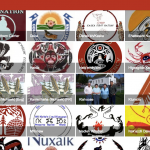1. The Endangered Languages Project
http://endangeredlanguages.com
In reading Bowers thoughts in week one, I was struck by his acknowledgement that “tribal leaders… see in the computer a means of revitalizing indigenous languages and preserving the traditional knowledge essential to tribal identity” (Bowes, 2000). I went looking for examples of this, especially for the Siksika language from my Treaty 7 area. Sure enough, I stumbled across The Endangered Languages Project, with a page of Siksika resources:
http://endangeredlanguages.com/lang/1677/guide
which included this little video:
https://www.youtube.com/watch?time_continue=197&v=4gqWBlT4j1s
Wouldn’t it be lovely if the YouTube translate feature could figure out Blackfoot!
References:
Bowers, C. A., Vasquez, M., & Roaf, M. (2000). Native people and the challenge of computers: Reservation schools, individualism, and consumerism. American Indian Quarterly, 24(2), 182-199.
2. Siksika Nation
http://siksikanation.com
The Siksika Nation website is a valuable resource for learning more about the Siksika and the Blackfoot Confederacy. There is information here about the chief and council, history and culture, news and upcoming events, and departments such as family services and justice. There is also a link to the Siksika Board of Education Website:
https://sites.google.com/SIKSIKABOARDOFEDUCATIOn.com/home
I love reading school newsletters. It’s a little window into what other students and teachers are experiencing.
3. KAIROS Blanket Exercise program
https://www.kairosblanketexercise.org/about/
This is an activity we did as professional development in our school, but there is a version available for many different audiences. Participants use blankets to represent land used 500 years ago and re-enact the consequences of events affecting First Nations peoples, including treaty-making, disease and residential schools.
4. Supporting the Truth and Reconciliation Commission of Canada: Calgary Catholic School District Call to Action
https://www.cssd.ab.ca/Programs/ProgramSupports/FirstNationsMetisandInuitEducation/Documents/CCSDandTRC_CalltoAction.pdf
In reading Michael Marker’s paper from Week 2, I started thinking about how two people can recall the same event differently. He discussed the proceedings of the Truth and Reconciliation Commission (TRC) and how Catholic clergy “…expressed deep resentments towards what they saw as the Commission’s emerging history of their schools; they saw it as incompatible with their order’s historical contributions to the survival and prosperity of natives peoples in Canada, and above all with their memories of what it was like participating in (and making personal sacrifices for) this project of human welfare” (Niezen, Truth and Indignation as quoted in Marker, 2015).
Priests and nuns involved in residential schools often saw themselves as doing the good work of the Catholic Church and believed that assimilation of aboriginal children was for their benefit, ignoring (or unaware of) alternative approaches being used south of the border.
Currently working for the Calgary Catholic School District, I am currently studying our board’s work with the Truth and Reconciliation Commission. I’m wondering if this is a possible research interest for me in this course.
References:
Marker, M. (2015). Borders and the borderless Coast Salish: decolonizing historiographies of Indigenous schooling. History of Education: Journal of the History of Education Society, 1-23
5. Calgary Catholic Diocese of Calgary – Letter from former Bishop Frederick Henry on Residential Schools (2000).
http://www.calgarydiocese.ca/news-events/bishops-blog/residential-schools.html
Written back in 2000, before the Truth and Reconciliation Commission, Bishop Frederick Henry of the Calgary Catholic Diocese wrote an open letter discussing the Church’s role in aboriginal education from 1857 through the 20th century. Specifically, he addresses lawsuits brought against the Anglican and Catholic churches by individuals who were sexually or physically abused in residential schools. He points out that it was a “church-state partnership…in which the government was the senior partner,” and that “[e]ssentially, the residential school system was a creature of the federal government even though the children in the schools were, in most cases in the immediate care of the churches” (Bishop Henry, 2000).
I would like to do some more research into the current position of the Calgary Catholic Diocese now that the first phase of the Truth and Reconciliation Commission has been completed.
